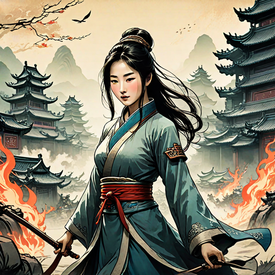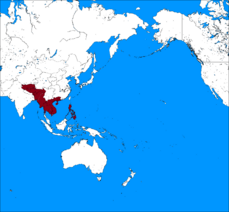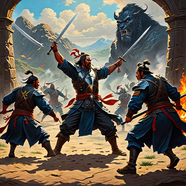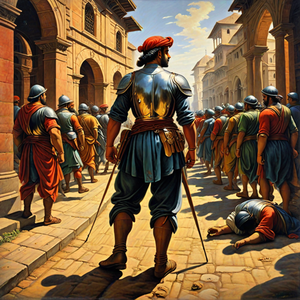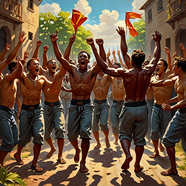History of Gesaria
*This page only contains information about the History of Gesaria. For the overview, see Gesaria .
| History of Gesaria | |
|---|---|
| Qanupaq: Izhtzariya ru Gyesariin | |
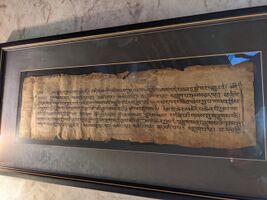 | |
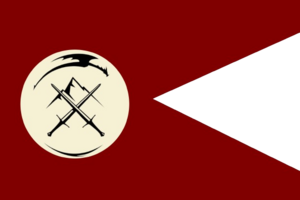 |
The History of Gesaria spans nearly seven milennia, from the first civilizations in 6000BC up to the present day. It is said that the first Gesarian civilizations emerged from the southern foothills of the Himalayas near the Indian Province of Sikkim. For most of Gesarian history, several kingdoms rise and fall in a cycle, a kingdom is invaded by another, the invading kingdom rules for a while, before it too is invaded repeating the cycle.
Prehistory
Paleolithic(2.2 m- 7k years ago)
It is widely believed that the first humans(homo erectus) arrived in the land of Gesaria around 2.2 million years ago and numerous fossils are scattered all throughout the nation, with the oldest fossils even dating back to 3 million years ago.
During this period, early humans lived a hunter-gatherer lifestyle, and often hunted in packs. The mountains of Gesaria also served as the homes of these early humans, living in massive caves such as the Yakaq Cave, which stretches for 1 mile and at a depth of 2.2 km below the surface at it's deepest point, functioning as the earliest city in Gesaria . While most residents just lived in the entrance of the cave and rarely explore the caves depths, ancient remains have been found as deep as 1.7 kms below the surface, indicating that the earliest residents of the cave would sometimes wander too deep and get lost, never to return.
Neolithic
The Neolithic Period began in Gesaria around 9000 years ago, with the invention of agriculture. Agriculture in Gesaria developed rapidly, with lush and spacious plains near the country being home to massive farms cultivating crops, primarily rice. It was also during this period when the first towns and cities developed, with the first settlement being Qana-Qanaqaa, founded in 6980BC. Qana-Qanaqaa is also the only settlement from this period still surviving today, and is the oldest continuously inhabited settlement in the world. These small towns gradually developed into the first civilization in Gesaria, the Empire of Qiaxing.
Metal Age(5500BC-1500BC)
The Metal Age began in Gesaria in 5500BC, with the region holding a vast amount of mineral deposits in it's mountains, which were mined by early humans to create items and weapons with metals like copper and iron. These metals also made Gesaria rich from trading with other countries. By 3000BC, the Qiaxing civilization was one of the most powerful and richest civilizations, with an estimated GDP today of 750 Billion USD.
The Legend of Yangchen and the Yangchenian Period(3000BC-2000BC)
The Legend
Main article: The Legend of Yangchen
It is said according to legend that the deity of a warrior princess named Yangchen Guul-la watches over the land of Gesaria, Poi(Tibet) and the neighboring region of Lilytopia ,constantly striking down what she deems as "forces of evil" who intend on disrupting the region's natural order. According to the accounts written by Dorjee Gyalzen, a Qakhok scholar around 3000 years ago, Princess Yangchen was born around 3000BC as the Empress of Gangtok, a city in Sikkim situated in the far North of Gesaria. It is said that Princess Yangchen was an extremely powerful princess whom everyone in the Kingdom feared and respected. In Dorjee's accounts, he mentions Princess Yangchen's extreme grip on power and stable rule in a region where rulers are often deposed from their thrones in a matter of months. It mentions how many critics of the Princess or people causing violence are often immediately thrown into dungeons where they are left to die in horrible conditions, but it also made the kingdom more peaceful and prosperous as there were hardly any conflicts between the many ethnic groups in the region.
Dorjee's accounts mention Yangchen's battle prowess and combat skills, especially displayed in the war against the invading tribe of Azunga, who suddenly invaded her Kingdom and burned many villages to the ground, killing many people.Yangchen immediately called up her army and faced the Azungas in battle, where Princess Yangchen single-handedly killed 7,000 men by herself. She went on to inflict many more defeats on the Azunga with her army of 7,000 , inflicting nearly 56,000-89,000 casualties on the Azunga, which represented nearly 75% of their male population. In March of 2975BC, her army reached the Azungan capital of Garjin, where she proceeded to defeat the city defenders and burn Garjin to the ground.
The sky on that day grew dark and cloudy as Yangchen entered Garjin with her army. The people of Garjin were all indoors trying to hide from her seething desire for revenge. The entire city was quiet until Yangchen screamed out loud "Men, burn this city to the ground and leave nothing breathing!". She lit a torch and began burning every house she came across as her men began killing those who were hiding inside. The sky glowed a dark orange as the city burned to ashes, along with the defenders of the city and the Azunga leadership while she watched from a hill away, satisfied with her revenge at the people who brought nothing but death and destruction to her domain. -The Legend of Yangchen, Chapter 21
In a diary recovered from the Talbushek Archives believed to belong to Empress Yangchen, she remarked on the sheer amounts of loot she had captured from the enemy, writing, but may not be accurately translated - "In my unmatched glory, I have captured nearly 200 tons of gold and riches from the enemy, as well as around 10,000 people from all ages and backgrounds that I can now make to do my bidding".It is believed that the captured slaves from Garjin were later used to construct Yangchen's opulent palace, which still stands today in the city of Qana-Qanaqaa.
Empress Yangchen died at the age of 46 in Caldemount in 2954BC, potentially of liver cirrhosis due to her extremely lavish lifestyle, but in the legend, it is stated that Yangchen died after the Gods called her back to Heaven, saying that she had used her Mandate of Heaven well.
The Yangchenian Empire
Empress Yangchen left behind a large and powerful empire, whose rule was passed on to her daughter, Empress Xiang. The Yangchenian Empire would go on to outshine all of it's predecessors and control a vast amount of territory from Pakistan to Thailand. Many aspects of Yangchenian Culutre still exists to this day, like the Yangchen Calendar and the Yangin language.
At least 40 emperors and empresses reigned over the Yangchenian Empire, with the last leader of the Empire believed to be Emperor Yuan Gyatso, who ruled around 2000BC for forty years. No one knows what happened after his reign, as the Yangchenian Empire is suddenly lost on the historical record, but experts believe that the Yangchenian Empire continued to exist for a few more centuries until a terrible natural disaster caused it to collapse.
The Tribal Period(1999BC-1200BC)
The Tribal Period was a period after the fall of the Yangchenian Empire where the people of the region return back to tribal nomadic lifestyles, largely caused by the collapse of the Yangchenian Government and the subsequent lost of knowledge that occured because of the collapse. With no government, people lost interest in studying and learning many of the Yangchenian practices and technologies, so they were lost to history. The urbanization that occured during the Yangchenian Period quickly reversed, and most of the population were now rural. The land of Gesaria is mostly made up again of nomadic tribes of the Qakhok people, a term used for people who are native to the Land of Gesaria and the ancient Kingdom of Yangchen. There were around 6 main tribes that dominated the land of Gesaria during this period: the Choden, Kungar, Ramlek, Azung, Pol-en and Yangin. These tribes were mostly divided amongst each other but surprisingly lived peacefully for eight hundred years, mostly sticking to their respective areas and stuck to those areas when getting resources. Relationships suddenly broke down between the tribes in 1200BC. It is said that the Azung and Ramlek tribes disagreed on the extent of their domains, leading to a skirmish between them that dragged all the other tribes into the conflict known as the First Sikkim War. Choden and Yangin backed the Ramleks while Kungar and Pol-en backed Azung.
The Ramleks, led by warlord Bishnu Rasmijoti however had vastly superior numbers and technology and easily managed to overwhelm the enemy tribes and force them to surrender after 1 and a half years of fighting. In the negotiations, it was decided that the 6 tribes would unite under Bishnu to form a new unified nation-state, the Kingdom of Bishnu Pradesh.
Bishnu Pradesh (1199BC-600BC)
Bishnu Pradesh was founded as a mutual union between all of the tribes, a pact in which each and every tribe will work for the betterment of the union. It worked and Bishnu Pradesh would go on to be a prosperous and powerful state and the dominating power in South and Southeast Asia, winning many battles against the other warlords in China, extending his empire from Delhi in the west to the Philippines to the east. One of the most famous victories of Bishnu Pradesh was in 790BC, when the twin warlords of Yuan Shao and Shang Jin invaded Bishnu's territory in Vietnam.They had a combined army of 32000, against Bishnu's 5600. Bishnu successfully defeated them at the Battle of Huanjin, forcing the twin warlords to retreat back into China.
It was the dawn of the winter solstice when the two warlords faced Bishnu.They had far superior numbers than Bishnu, and they were confident on their victory. But they were no match for the strong and powerful Bishnu who soundly defeated them. A thousand men couldn't equal to his strength. The two warlords were forced to retreat like cowards, having learned their lesson - "If you dare to attack the man who equals a thousand men, you will bring death and dishonor to yourself and your nation. - Biography of Bishnu by Akar Dhargey, Chapter 10
Legacy
Bishnu would carve up a massive empire and cemented his legacy as one of the greatest military generals in history, far outmatching most generals for his time. He was known for his early use of modern-day tactics like blitzkrieg and exhaustion and attrition in fighting enemies. At the empire's peak, it was estimated that around 5 million people called the empire home, representing 10% of the world population at the time. Bishnu Pradesh was also one of the very few stable and long-lasting nation-states that existed at the time, with Bishnu Pradesh lasting for 600 years.
Bishnu Pradesh is widely known in the country as the official beginning of Gesaria, as Bishnu was born and raised in Khuukh-Uzuur in modern day Gesaria. To this day, Bishnu Rasmijoti is considered as the founder and father of Gesaria , unlike later leaders because they only served to refound Bishnu Pradesh.
Bishnu Rasmijoti died at the age of 64 in 1160BC in Khantuan (modern day Jezero in the Bazzo Province), surrounded by his advisors and soldiers. At his funeral in Khuukh-Uzuur, nearly 15,000 men attended, saluting the man who brought glory and honor to this land. Bishnu's son, Akumu Rasmijoti would inherit the throne from his father, and further solidify Bishnu Pradesh's existence.
The Bhavikian Period and the Dark Age(600BC-100BC)
Fall of Bishnu Pradesh
After the era of Bishnu, his descendants would continue on ruling Bishnu Pradesh for 600 years until 600BC, when an incompetent leader name Dujom Garab would rise to the Bishnute throne. Dujom was a weak leader, while his advisors, had grown corrupt with all of the wealth flowing into the empire. As such, the state of Bishnu Pradesh started growing unstable, as many of the tribes that had allied with Bishnu 600 years ago, felt like they were being betrayed with the government's increasing greed and corruption. It also didnt help that a protest carried out by the Kalmyuk tribe for a more fair government was brutally suppressed leading to the death of 6000 in an incident known as the Red Night Incident. Outraged with the brutal suppression, a period of infighting erupted between the tribes and the main government, known as the Second Sikkim War, resulting in many of the tribes cutting ties with Garab's government.
Dujom immediately called up the army and began a brutal campaign to crush the rebellion, with many atrocities being committed by his army. It was estimated that 12% of all tribespeople in the country were brutally slaughtered in the campaign, notably causing the extinction of the Uyad Tribe and the Uyadin Language.
The Founding of the Kingdom of Bhavikia and Kozudia (KBK)
Another warlord to the south in Manipur, named Bhavik Agarwal, noticing Bishnu Pradesh's increasing instability, launched an invasion of the empire. The Bishnute army, underequipped and undersupplied due to the weak and corrupt government,as well as being distracted with staving off the rebellion were soundly defeated and massacred by Bhavik's army, leading a genocidal campaign of conquest against Bishnu Pradesh. Bhavik soon reached Bishnu Pradesh's capital in Choibalsan, entering the city and burning it to the ground, slaughtering many civilians along the way in a style similar to Yangchen's conquests one thousand years prior. Bhavik's army seized the palace, forcing Khan Dujom Garab to step down from the throne where he was beheaded and displayed in public a few days later. After Bhavik successfully took control of the Bishnute capital, he immediately proclaimed himself the new emperor and officially declared the new Kingdom of Bhavikia and Kozudia (KBK), stemming from his name and the name of his allied warlord, Kozud Gyalwa.
The Brutality of Bhavikian Rule
In the following years after the foundation of the KBK, the people of the former Bishnu Pradesh were enslaved and oppressed by the new government based in Bhana in Manipur. Atrocities were frequent and the new government ruled the land with an iron fist. One of the scholars in hiding from this time, Yaim Jainpur, described this period as being dominated with fear and anger. "Everyone was angry at the new government, but they were too afraid to say it." He also described a feeling of hopelessness and despair, feeling that Bishnu Pradesh's potential for a bright and prosperous future was immediately squandered in a matter of weeks.
Atrocities
The new government committed many atrocities on the Qakhok and Bishnute people. Many people were forced into slavery to harvest grain and cotton. Children were being kidnapped from their villages and forced to mine coal in the Himalayas, with hardly any clothing in the regularly freezing temperatures. Children unable to meet their quotas often have fingers removed or at their worst, their entire families shot and killed in front of them while being brutally punished for any expression of grief. Women are often abused and forced into unspeakable acts by their masters, as well as being forcefully starved if they do not comply with the orders and desires of the "master race". Most of the strongest and most capable men are forced to do hard labor like lifting bricks to construct massive houses and palaces, forced to work 18 hours a day and fed very little, only around one small bowl of rice every day.
The new government also engages in purposely using famine as a means to control the population from rebellion, often cutting entire villages off from food if even one person acts rebelliously. The people in these villages were so deprived of food that they started cannibalizing each other. Those who were old or young who could not contribute to the village were often devoured. Families were forced into eating their own relatives, and children often saw their grandparents being eaten. Life was terrible, but no one could gather enough support to overthrow this new government.
Death of Bhavik Agarwal
Bhavik Agarwal died at the age of 56, likely because of colon cancer , and the throne was passed on to Kozud Gyalwa, who upon inheriting the throne, immediately abdicated for Bhavik's son, Omar Agarwal, to take the throne. The brutality of the KBK's reign continued long after Bhavik's death, lasting all the way to 100BC as the empire kept it's grip on the populace. But things started to change towards the favor of the oppressed people.
Ram Acharya and the Second Bishnute Empire
After the collapse of Bishnu Pradesh, the tribe of Bishnu, the Ramlek was divided into twelve tribes known as the Twelve Tribes of Bishnu. These are the Kalmuks, Sogbyuls, Xhaksus, Baxzos, Aldines, Sopians, Eevsumig, Gorgyug, Qanaqs, Ilmoks, Derochronids, Chibutallen, and Kahll-Imqq. These tribes were largely fighting with each other at first, but once again in 100BC they united under the rule of a Qakhok Scholar from the Eevsumig tribe named Ram Acharya. Ram was actually born and raised in relative luxury and comfort, born in Talbushek and was sent to an exclusive private school to pursue History. It is said that when his professor started discussing about the Qakhok and the Bishnute tribes, talking about their inferiority to the Bhavikian race, Ram Acharya felt angered and knew that he had to be one to liberate his people from this oppression. After he finished his studies, he returned to the Qakhok homeland of Gesaria (known back then as Yangchenia, but the term is now use today for the land north of Gesaria), and began to gather the tribes to launch a revolution against their conquerors.
The Ram Revolution
Ram gathered an army of 3000 and overthrew the government of their province, successfully seizing the Choibalsan Palace and capturing the governor, whom they forced to give up power. From the balcony of the Palace, Ram Acharya declared the independence of Bishnu Pradesh as a separate and sovereign entity from the KBK. Ram knew that this would almost certainly ignite the wrath of the KBK, and he knew that they would not hesitate to slaughter and massacre his people in an act of genocide. But to him, this was the only way to secure a brighter future for himself and his people.
In a speech he gave to his army, which functioned as the official Declaration of Independence he said:
"We of this generation, and as the descendants of Bishnu and Yangchen, as the future of the Qakhok people, as the light of hope for all people in this region, as the beacon of resistance against tyranny and oppression, as the avengers of the suffering our ancestors endured, and as the people who will carry the torch of our and our ancestors legacy into the future, we have for ourselves a great responsibility. The fate of our people and all people of this region lies with us. If we fail, then our children will never get to see a world of prosperity and freedom. We would likely be wiped off the face of this planet, every man, woman and children here would be systematically killed. We have already made the first move, and now it is our duty to finish this. Even if we lose, it is better for our people to die loud than to fade away. With this, I officially declare the start of a new nation, built on peace and equality for all peoples, blind to race and class. --- Ram Acharya
Ram Acharya's idea of freedom and independence swept throughout KBK. Many slaves began protesting against the government, often refusing to do what their masters had ordered them, despite brutal punishments. These protests soon started devolving into riots as the long oppressed slaves began unleashing all of the bottled up anger that they had stored from all of their mistreatment. The KBK armies originally managed to quell these rebellions, but soon they were overwhelmed and many of the provinces, whose governments had been taken by the rebels, defected to Ram's side. By 90BC, the once large empire of the KBK had dwindled down to only a few towns and villages in Manipur as Ram Acharya claimed a decisive victory and freed many of the people from slavery.
After the fall of the KBK, Ram Acharya officially established the Second Bishnute Empire in its place, built on the idea of equality and freedom, as well the abolition of slavery as a practice. This was the first instance of an Asian nation enacting these policies. It wasn't long until the Second Bishnute Empire grew prosperous and under these new ideals, the people of the Second Bishnute Empire were considered as one of the freest and happiest people in the world at the time.
Ram Acharya continued to rule the empire until 10BC, where he died at the ripe old age of 102. His descendants continued to rule the empire until 250AD, when the Second Bishnute Empire was conquered by the Wei Kingdom (Jin Dynasty).
Chinese Rule (250AD-1270AD)
Chinese Dynasties ruled over Bishnu Pradesh for 1010 years, greatly influencing modern-day Gesarian Culture to be more Chinese and Tibetan influenced than Indian influenced. This is also the period where the land of Bishnu Pradesh fully recovered from the centuries of Bhavikian rule, and also developed many parts of the country, especially in the rural areas. The city of Talbushek, initially a small rural farming and herding village, grew into a major trading village and the sixth largest trading outpost in the Jin Dynasty. During the time of the Chinese, Talbushek would be known as the crown jewel of the south and largest trading market in South Asia, with goods flowing into Talbushek from places like India, Tibet and Indomalaya. Chinese beliefs like Confucianism and Taoism were also adopted.
It is believed that during Chinese Rule, the seat of power moved from the Choibalsan Palace back to the Palace of Yangchen in Qana-Qanaqaa. During the Bhavikian Period, the palace had fallen into disrepair both due to it's age (already 2400 years old in 600BC) and also the Bhavikian Empire's attempt to destroy the Qakhok's deemed "inferior culture". During the reign of the Chinese, they spent outrageous amounts of money into rebuilding the palace, with the Chinese constructing new buildings in the complex, like a massive swimming pool and even a spa. Despite the Chinese's massive remodeling, they made sure to leave the original buildings, the temple, living quarters and the dungeons untouched.
Starting in 1000AD, a lack of historical records becomes prevalent in documenting Gesarian History. The lack of historical documentation from this era is linked to the Chinese-Mongol war in 1271. As the Chinese began to lose and the Mongols approached, they burned many of their manuscripts containing their technology, and in the process, also burned many of the historical records. When the Mongols took over the land of Bishnu Pradesh, they also contributed to the destruction of the historical records by burning a library in the city of Al-Zayn.
In 1271, Bishnu Pradesh was absorbed into the Yuan Dynasty of Mongolia.
Mongol Rule (1271-1294)
The Mongols took over the region of Bishnu Pradesh in 1260BC, incorporating it into the Yuan Dynasty eleven years later, with the region falling under the rule of the Khan, Imhran Shan. This period in history is widely considered as the "Golden Age". Living standards improved, infrastructure was developed and the system of leadership was reformed. Qakhok culture thrived once more under the benevolent Khan's reign.
Etymology behind the name "Gesaria"
The Mongols, arriving in Bishnu Pradesh, witnessed a battle between Indian Tribes and the Qakhok Gurkhas near the city of Xhaksu. The Mongols were impressed at the Qakhok Gurkhas's fighting skills, and named the region in honor of them, using the term "Uul-Gyesar" when referring to the region. This name comes from the Epic of King Gesar, a famous Tibetan epic depicting Gesar, a legendary warlord from the Kingdom of Ling . "Uul-Gyesar" is therefore supposed to mean "Mountain of Gesar" or "The Land of the Mountain Warriors",as Gesar was a warrior.
In the current era,the name Uul-Gyesar is interpreted differently,now also meaning "Land of the Mountain Emperors",as the name Gesar itself comes from the word "Kaisar" meaning Emperor.
Independence and the Founding of the Kingdom/Queendom of Gesaria
When the Mongol Empire was divided in 1294, the Khanate of Uul-Gyesar was granted independence as a seperate Khanate under the rule of the newly crowned Queen, Arudshebet "Aisha" Dawa.
Collapse and Recovery - The Gesarian Renaissance
Despite their newly found independence, this quickly proved to be disastrous for Gesaria. Now that they were independent, the financial aid that the Mongols were giving to the country quickly ceased, and the country quickly fell into poverty. Slums spread and crime rates increased. Queen Aisha immediately began creating a plan to revive the kingdom and lift it out of poverty. To solve the instability in the country, Queen Aisha declared martial law. She had her opponents and the leaders of the party against her killed. She imposed a curfew, suspended rights, banned free expression, and legalized the use of torture against prisoners. Despite these brutal measures, it worked in curbing violence which allowed the government to enact their reforms. She encouraged neighboring nations to invest in Gesaria in exchange for her support in any conflicts they were in. With the money she got, she built houses and sold them to people at a low price. She built a system of socialism and all land belonged to the state. People were given land to farm and encouraged to set up businesses. Port usage taxes are lower compared to others. It attracted merchant vessels that came to the port of Gesaria. She allowed foreign businesses to enter the country. She lowered the minimum wage to attract more foreigners. The businesses built in Gesaria all became successful and the amount of tax paid to the government grew. The country became rich and their period of poverty ended. The Queendom of Gesaria had established itself as a large commercial hub for merchants and traders in the region, constantly bringing in essential capital to the country. Queen Aisha died on 8 May 1334 in Caldemount, dying at the same place that her ancestors Yangchen and Ram Acharya chose to die in. She was widely regarded as the "Hero of Gesaria" for her leadership in the development of the country. In honor of her and her legendary ancestors, Caldemount was designated as the national capital of Gesaria, with the cities of Khuukh-Uzuur (birthplace of Bishnu), Talbushek (birthplace of Ram Acharya) and Qana-Qanaqaa(birthplace of Empress Yangchen) serving as cultural capitals of the nation.
The Industrial Revolution - Environment over Industry
WIP
